Hisham Cholakkal
equal contribution
How Good are Foundation Models in Step-by-Step Embodied Reasoning?
Sep 18, 2025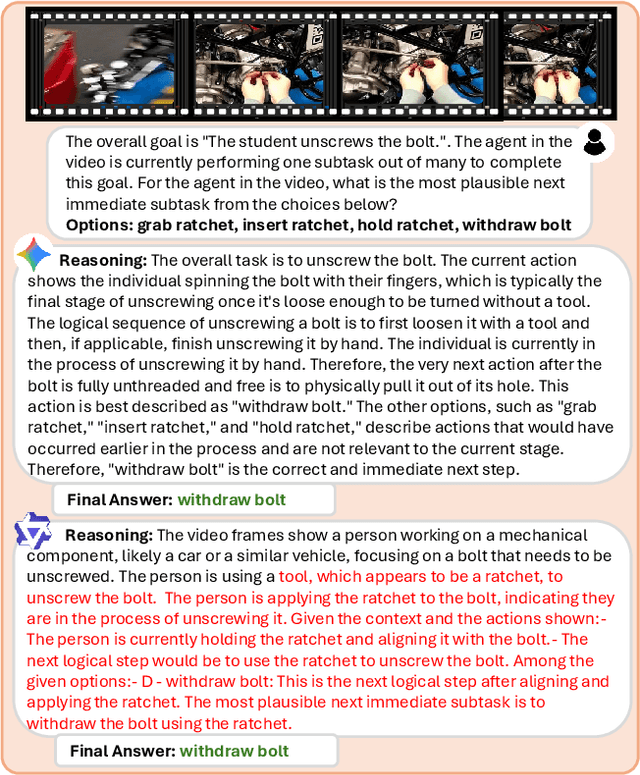
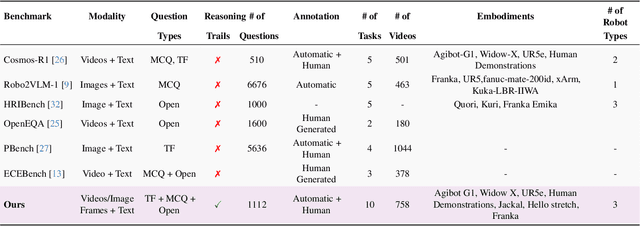
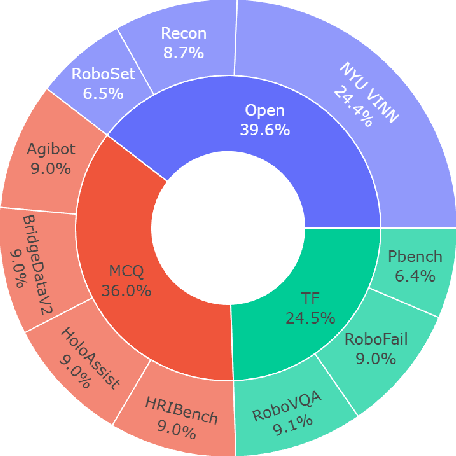
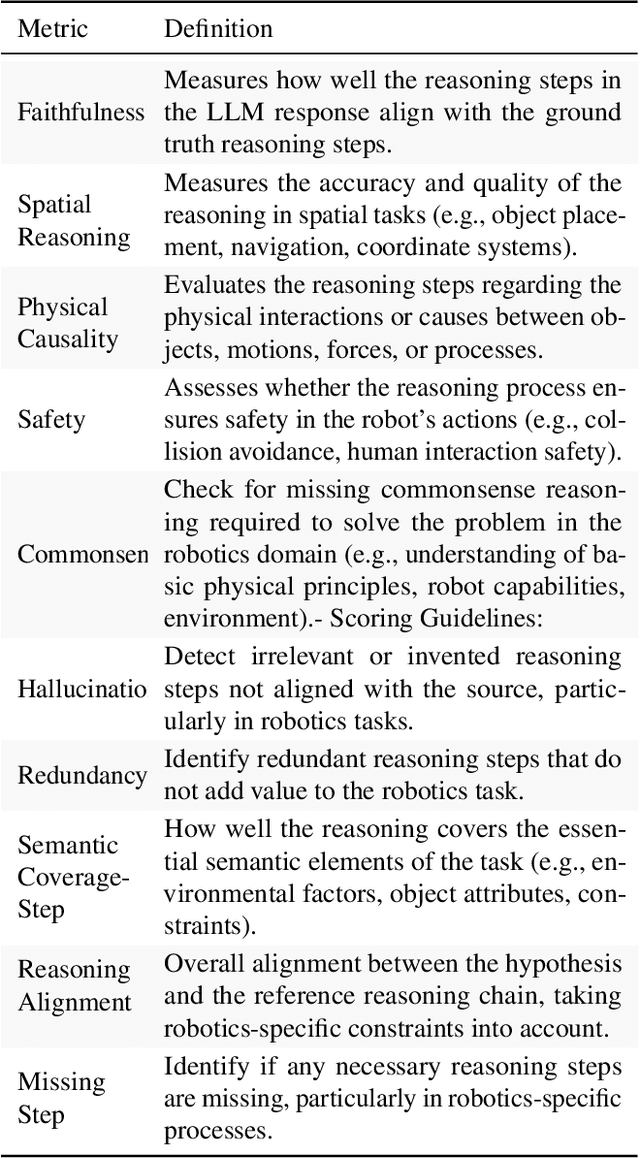
Abstract:Embodied agents operating in the physical world must make decisions that are not only effective but also safe, spatially coherent, and grounded in context. While recent advances in large multimodal models (LMMs) have shown promising capabilities in visual understanding and language generation, their ability to perform structured reasoning for real-world embodied tasks remains underexplored. In this work, we aim to understand how well foundation models can perform step-by-step reasoning in embodied environments. To this end, we propose the Foundation Model Embodied Reasoning (FoMER) benchmark, designed to evaluate the reasoning capabilities of LMMs in complex embodied decision-making scenarios. Our benchmark spans a diverse set of tasks that require agents to interpret multimodal observations, reason about physical constraints and safety, and generate valid next actions in natural language. We present (i) a large-scale, curated suite of embodied reasoning tasks, (ii) a novel evaluation framework that disentangles perceptual grounding from action reasoning, and (iii) empirical analysis of several leading LMMs under this setting. Our benchmark includes over 1.1k samples with detailed step-by-step reasoning across 10 tasks and 8 embodiments, covering three different robot types. Our results highlight both the potential and current limitations of LMMs in embodied reasoning, pointing towards key challenges and opportunities for future research in robot intelligence. Our data and code will be made publicly available.
AI in Agriculture: A Survey of Deep Learning Techniques for Crops, Fisheries and Livestock
Jul 29, 2025Abstract:Crops, fisheries and livestock form the backbone of global food production, essential to feed the ever-growing global population. However, these sectors face considerable challenges, including climate variability, resource limitations, and the need for sustainable management. Addressing these issues requires efficient, accurate, and scalable technological solutions, highlighting the importance of artificial intelligence (AI). This survey presents a systematic and thorough review of more than 200 research works covering conventional machine learning approaches, advanced deep learning techniques (e.g., vision transformers), and recent vision-language foundation models (e.g., CLIP) in the agriculture domain, focusing on diverse tasks such as crop disease detection, livestock health management, and aquatic species monitoring. We further cover major implementation challenges such as data variability and experimental aspects: datasets, performance evaluation metrics, and geographical focus. We finish the survey by discussing potential open research directions emphasizing the need for multimodal data integration, efficient edge-device deployment, and domain-adaptable AI models for diverse farming environments. Rapid growth of evolving developments in this field can be actively tracked on our project page: https://github.com/umair1221/AI-in-Agriculture
HyRet-Change: A hybrid retentive network for remote sensing change detection
Jun 15, 2025Abstract:Recently convolution and transformer-based change detection (CD) methods provide promising performance. However, it remains unclear how the local and global dependencies interact to effectively alleviate the pseudo changes. Moreover, directly utilizing standard self-attention presents intrinsic limitations including governing global feature representations limit to capture subtle changes, quadratic complexity, and restricted training parallelism. To address these limitations, we propose a Siamese-based framework, called HyRet-Change, which can seamlessly integrate the merits of convolution and retention mechanisms at multi-scale features to preserve critical information and enhance adaptability in complex scenes. Specifically, we introduce a novel feature difference module to exploit both convolutions and multi-head retention mechanisms in a parallel manner to capture complementary information. Furthermore, we propose an adaptive local-global interactive context awareness mechanism that enables mutual learning and enhances discrimination capability through information exchange. We perform experiments on three challenging CD datasets and achieve state-of-the-art performance compared to existing methods. Our source code is publicly available at https://github.com/mustansarfiaz/HyRect-Change.
* Accepted at IEEE IGARSS 2025
InceptionMamba: Efficient Multi-Stage Feature Enhancement with Selective State Space Model for Microscopic Medical Image Segmentation
Jun 13, 2025Abstract:Accurate microscopic medical image segmentation plays a crucial role in diagnosing various cancerous cells and identifying tumors. Driven by advancements in deep learning, convolutional neural networks (CNNs) and transformer-based models have been extensively studied to enhance receptive fields and improve medical image segmentation task. However, they often struggle to capture complex cellular and tissue structures in challenging scenarios such as background clutter and object overlap. Moreover, their reliance on the availability of large datasets for improved performance, along with the high computational cost, limit their practicality. To address these issues, we propose an efficient framework for the segmentation task, named InceptionMamba, which encodes multi-stage rich features and offers both performance and computational efficiency. Specifically, we exploit semantic cues to capture both low-frequency and high-frequency regions to enrich the multi-stage features to handle the blurred region boundaries (e.g., cell boundaries). These enriched features are input to a hybrid model that combines an Inception depth-wise convolution with a Mamba block, to maintain high efficiency and capture inherent variations in the scales and shapes of the regions of interest. These enriched features along with low-resolution features are fused to get the final segmentation mask. Our model achieves state-of-the-art performance on two challenging microscopic segmentation datasets (SegPC21 and GlaS) and two skin lesion segmentation datasets (ISIC2017 and ISIC2018), while reducing computational cost by about 5 times compared to the previous best performing method.
TAViS: Text-bridged Audio-Visual Segmentation with Foundation Models
Jun 13, 2025Abstract:Audio-Visual Segmentation (AVS) faces a fundamental challenge of effectively aligning audio and visual modalities. While recent approaches leverage foundation models to address data scarcity, they often rely on single-modality knowledge or combine foundation models in an off-the-shelf manner, failing to address the cross-modal alignment challenge. In this paper, we present TAViS, a novel framework that \textbf{couples} the knowledge of multimodal foundation models (ImageBind) for cross-modal alignment and a segmentation foundation model (SAM2) for precise segmentation. However, effectively combining these models poses two key challenges: the difficulty in transferring the knowledge between SAM2 and ImageBind due to their different feature spaces, and the insufficiency of using only segmentation loss for supervision. To address these challenges, we introduce a text-bridged design with two key components: (1) a text-bridged hybrid prompting mechanism where pseudo text provides class prototype information while retaining modality-specific details from both audio and visual inputs, and (2) an alignment supervision strategy that leverages text as a bridge to align shared semantic concepts within audio-visual modalities. Our approach achieves superior performance on single-source, multi-source, semantic datasets, and excels in zero-shot settings.
A Culturally-diverse Multilingual Multimodal Video Benchmark & Model
Jun 08, 2025Abstract:Large multimodal models (LMMs) have recently gained attention due to their effectiveness to understand and generate descriptions of visual content. Most existing LMMs are in English language. While few recent works explore multilingual image LMMs, to the best of our knowledge, moving beyond the English language for cultural and linguistic inclusivity is yet to be investigated in the context of video LMMs. In pursuit of more inclusive video LMMs, we introduce a multilingual Video LMM benchmark, named ViMUL-Bench, to evaluate Video LMMs across 14 languages, including both low- and high-resource languages: English, Chinese, Spanish, French, German, Hindi, Arabic, Russian, Bengali, Urdu, Sinhala, Tamil, Swedish, and Japanese. Our ViMUL-Bench is designed to rigorously test video LMMs across 15 categories including eight culturally diverse categories, ranging from lifestyles and festivals to foods and rituals and from local landmarks to prominent cultural personalities. ViMUL-Bench comprises both open-ended (short and long-form) and multiple-choice questions spanning various video durations (short, medium, and long) with 8k samples that are manually verified by native language speakers. In addition, we also introduce a machine translated multilingual video training set comprising 1.2 million samples and develop a simple multilingual video LMM, named ViMUL, that is shown to provide a better tradeoff between high-and low-resource languages for video understanding. We hope our ViMUL-Bench and multilingual video LMM along with a large-scale multilingual video training set will help ease future research in developing cultural and linguistic inclusive multilingual video LMMs. Our proposed benchmark, video LMM and training data will be publicly released at https://mbzuai-oryx.github.io/ViMUL/.
Agent-X: Evaluating Deep Multimodal Reasoning in Vision-Centric Agentic Tasks
May 30, 2025Abstract:Deep reasoning is fundamental for solving complex tasks, especially in vision-centric scenarios that demand sequential, multimodal understanding. However, existing benchmarks typically evaluate agents with fully synthetic, single-turn queries, limited visual modalities, and lack a framework to assess reasoning quality over multiple steps as required in real-world settings. To address this, we introduce Agent-X, a large-scale benchmark for evaluating vision-centric agents multi-step and deep reasoning capabilities in real-world, multimodal settings. Agent- X features 828 agentic tasks with authentic visual contexts, including images, multi-image comparisons, videos, and instructional text. These tasks span six major agentic environments: general visual reasoning, web browsing, security and surveillance, autonomous driving, sports, and math reasoning. Our benchmark requires agents to integrate tool use with explicit, stepwise decision-making in these diverse settings. In addition, we propose a fine-grained, step-level evaluation framework that assesses the correctness and logical coherence of each reasoning step and the effectiveness of tool usage throughout the task. Our results reveal that even the best-performing models, including GPT, Gemini, and Qwen families, struggle to solve multi-step vision tasks, achieving less than 50% full-chain success. These findings highlight key bottlenecks in current LMM reasoning and tool-use capabilities and identify future research directions in vision-centric agentic reasoning models. Our data and code are publicly available at https://github.com/mbzuai-oryx/Agent-X
Fann or Flop: A Multigenre, Multiera Benchmark for Arabic Poetry Understanding in LLMs
May 26, 2025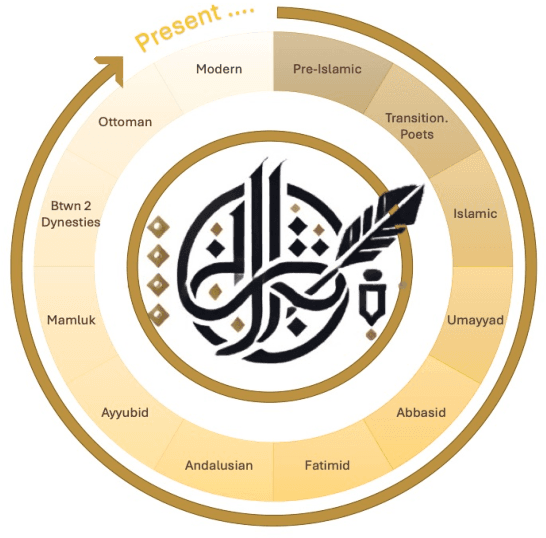

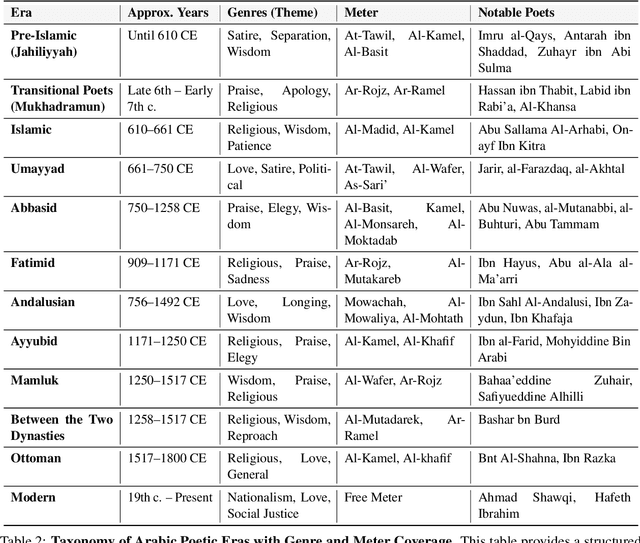
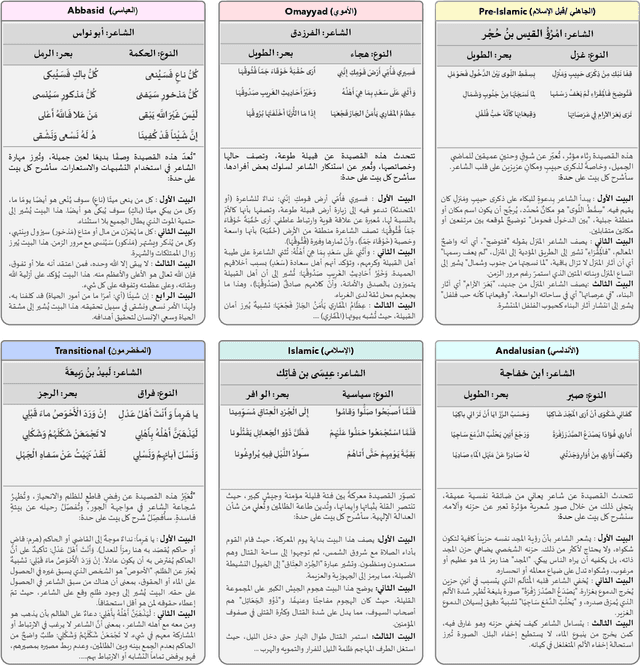
Abstract:Arabic poetry is one of the richest and most culturally rooted forms of expression in the Arabic language, known for its layered meanings, stylistic diversity, and deep historical continuity. Although large language models (LLMs) have demonstrated strong performance across languages and tasks, their ability to understand Arabic poetry remains largely unexplored. In this work, we introduce \emph{Fann or Flop}, the first benchmark designed to assess the comprehension of Arabic poetry by LLMs in 12 historical eras, covering 14 core poetic genres and a variety of metrical forms, from classical structures to contemporary free verse. The benchmark comprises a curated corpus of poems with explanations that assess semantic understanding, metaphor interpretation, prosodic awareness, and cultural context. We argue that poetic comprehension offers a strong indicator for testing how good the LLM understands classical Arabic through Arabic poetry. Unlike surface-level tasks, this domain demands deeper interpretive reasoning and cultural sensitivity. Our evaluation of state-of-the-art LLMs shows that most models struggle with poetic understanding despite strong results on standard Arabic benchmarks. We release "Fann or Flop" along with the evaluation suite as an open-source resource to enable rigorous evaluation and advancement for Arabic language models. Code is available at: https://github.com/mbzuai-oryx/FannOrFlop.
ARB: A Comprehensive Arabic Multimodal Reasoning Benchmark
May 22, 2025Abstract:As Large Multimodal Models (LMMs) become more capable, there is growing interest in evaluating their reasoning processes alongside their final outputs. However, most benchmarks remain focused on English, overlooking languages with rich linguistic and cultural contexts, such as Arabic. To address this gap, we introduce the Comprehensive Arabic Multimodal Reasoning Benchmark (ARB), the first benchmark designed to evaluate step-by-step reasoning in Arabic across both textual and visual modalities. ARB spans 11 diverse domains, including visual reasoning, document understanding, OCR, scientific analysis, and cultural interpretation. It comprises 1,356 multimodal samples paired with 5,119 human-curated reasoning steps and corresponding actions. We evaluated 12 state-of-the-art open- and closed-source LMMs and found persistent challenges in coherence, faithfulness, and cultural grounding. ARB offers a structured framework for diagnosing multimodal reasoning in underrepresented languages and marks a critical step toward inclusive, transparent, and culturally aware AI systems. We release the benchmark, rubric, and evaluation suit to support future research and reproducibility. Code available at: https://github.com/mbzuai-oryx/ARB
Open-Set Semi-Supervised Learning for Long-Tailed Medical Datasets
May 20, 2025Abstract:Many practical medical imaging scenarios include categories that are under-represented but still crucial. The relevance of image recognition models to real-world applications lies in their ability to generalize to these rare classes as well as unseen classes. Real-world generalization requires taking into account the various complexities that can be encountered in the real-world. First, training data is highly imbalanced, which may lead to model exhibiting bias toward the more frequently represented classes. Moreover, real-world data may contain unseen classes that need to be identified, and model performance is affected by the data scarcity. While medical image recognition has been extensively addressed in the literature, current methods do not take into account all the intricacies in the real-world scenarios. To this end, we propose an open-set learning method for highly imbalanced medical datasets using a semi-supervised approach. Understanding the adverse impact of long-tail distribution at the inherent model characteristics, we implement a regularization strategy at the feature level complemented by a classifier normalization technique. We conduct extensive experiments on the publicly available datasets, ISIC2018, ISIC2019, and TissueMNIST with various numbers of labelled samples. Our analysis shows that addressing the impact of long-tail data in classification significantly improves the overall performance of the network in terms of closed-set and open-set accuracies on all datasets. Our code and trained models will be made publicly available at https://github.com/Daniyanaj/OpenLTR.
 Add to Chrome
Add to Chrome Add to Firefox
Add to Firefox Add to Edge
Add to Edge